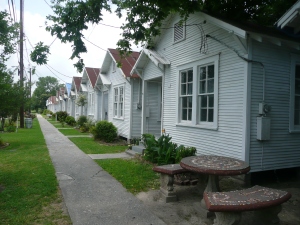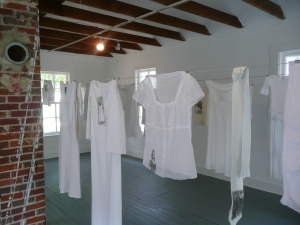
Project Row Houses
I’m standing on the corner of Smith and Elgin, not far from Houston’s Third Ward. It’s May but with the heat and humidity it might as well be August, so I’m relieved when Tim Martinez pulls up, and I slip into his air-conditioned car.
Tim’s the Director of Development/PR at Project Row Houses (PRH), a neighborhood-based art and cultural organization located in Houston’s Northern Third Ward, one of the city’s oldest African-American communities.
PRH founder Rick Lowe, artist, community activist and member of the U.S.-Japan Innovators Network, was one of four Americans who participated in Invigorating Communities, Designing for Inclusion in November 2007. The two-day retreat in Kyoto brought together architects, urban planners, and leaders in culture and civil society from the United States and Japan to share ideas on urban revitalization, social inclusion, the role of arts and culture in stimulating local economies.
In Kyoto, Rick gave a compelling presentation on PRH, explaining how the organization was established on the site of 22 abandoned shotgun houses, on the principle that art and the community it creates can be the foundation for revitalizing depressed inner-city neighborhoods. This principle was is in part based on the philosophy of German artist Joseph Beuys (1921 – 1986) who coined the phrase “social sculpture,” which transformed the idea of sculpture as an art form into a social activity.
Business has brought me to Houston, and I am eager to see PRH for myself.
As Tim and I cross over Freeway 288 into the heart of the Third Ward, he explains how home owners there have successfully staved off the condo developers that seem to have overtaken much of the city. “People decided the Third Ward is not for sale,” he says.

The Third Ward was once a center of African American culture in Houston, with Dowling Street at its hub. We pass the Eldorado Ballroom, an unassuming art deco building that as a night club played host to the likes of BB King, Count Basie and numerous other blues and jazz luminaries until it closed in the 1970s. PRH renovated the ballroom and reopened it in 2003 and continues to make improvements.
We park in the shade under a large tree across the street from a row of white, single-storey wood buildings. These are some of the 22 row houses PRH uses for art installations and studios, as well as for their artist-in-residence program. Seven of the buildings are used for PRH’s Young Mothers Residential Program, where single mothers 18-26 live in fully furnished updated row houses while receiving mentoring and finishing their education, Tim explains.
Crossing the street, we step into a two-story brick building, a former grocery store which now serves as PRH’s office. The first floor is used as gallery space.
Upstairs, I meet Cheryl Parker, PRH’s Executive Director. On this particular day, Rick Lowe is in Washington DC. He’s been invited to the White House to talk about the role of art in fostering community revitalization, Cheryl explains.
I ask Cheryl what of PRH’s current projects she find most exciting, and she immediately replies, “Home. Space. Place.” The exhibition, or “round” as she and Tim call it, comprises works by eight artists on the themes of home, identity, culture, struggles and perseverance, she says. PRH holds two major rounds a year, as well as a special program in the summer engaging local college students.
Tim and I step outside and in a few feet we are on the porch of the nearest shotgun house. Inside, I am amazed at how small it is.

The next several houses are being used as art installation spaces for “Home. Space. Place.” “It’s one house per artist,” Tim explains. “We want the artists to think of the houses as a blank canvass.”
In one house, the main space has been divided into several small rooms. The walls in one room have been papered over with red photocopies of a letter written by the artist’s grandmother, describing the effects of Hurricane Betsy fifty years ago.

In another room, the same artist, Rashida Ferdinand, has covered the walls with sand and broken glass, echoing the destruction brought by hurricanes.
In another house, artist Lisa Qualls has strung clothes lines draped with white linen from wall to wall. “The idea here was to collect clothes line stories from local people” Tim explains – stories relating to hanging washing out to dry.

In a third house, Cynthia Giachetti has created a ceramic quilt, reflecting the artist’s interest in preserving and protecting community.
We head back outside and Tim points out a series of new two-storey duplexes. Designed by Rice University architecture students, the clapboard houses echo the best qualities of shotgun houses and are being leased to families at affordable rates by Row House CDC, a spin-off from PRH which focuses on economic development in the Third Ward.
I ask Tim about future plans for expansion. “CDC is planning to do another development of duplexes about a mile away from here,” he says, as we make our way back to the office for a glass of water and much-needed respite from the heat.

Eight of the 24 families that have moved into the current duplexes include artists as family members, which has helped new-comers engage in the community. “They wanted to be here because they wanted to be part of the community,” he says.
Our tour complete, Tim is kind enough to give me a ride back to my hotel.
Note to anyone traveling to Houston: Home. Space. Place. continues through June 21.
(Daniel Rosenblum)




